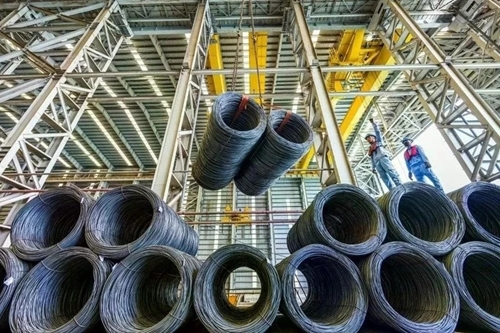Private firms taking the lead
According to the Ministry of Industry and Trade (MoIT)’s Industry Agency, private firms have led the sector in investment, technological innovation, capacity enhancement, and effective business operations.
Before private companies entered the scene, the steel industry relied primarily on the Vietnam Steel Corporation and its subsidiaries. The production process was rudimentary and fragmented, resulting in low quality and limited output. Before 2000, the country's total crude steel production stood at only some 100,000 tons annually.
    |
 |
|
Hoa Phat Group targets first railway track products to be produced by May 2027. (Photo: Hoa Phat Group) |
However, following Doi Moi (renewal) and market opening, steel production has transformed significantly thanks to active participation from private enterprises like Hoa Phat, Hoa Sen, and Viet Duc. They have invested big in advanced production technologies and completed steel manufacturing lines with high-capacity plants, resulting in diverse and high-quality products, the agency said.
Last year, three big private firms – Hoa Phat, Formosa Ha Tinh Steel Corporation, and VAS Steel Nghi Son Company Limited – produced more than 17 million tons of crude steel, or fivefold higher than the output of the Vietnam Steel Corporation.
Director of the Industry Agency Tran Viet Hoa said that private firms have demonstrated a remarkable ability to seize opportunities and adapt quickly to stringent standards and requirements to access demanding markets.
They have targeted added value with hot-rolled steel sheets, high-quality steel, and sophisticated galvanized steel, which are a crucial link in the steel value chain, he said, pointing out that the private sector handle 100% of galvanized steel production and their products are now present in such choosy markets as the E.U., the U.S., and ASEAN.
Hoa Phat Group and Primetals Technologies have signed a contract to supply a high-quality steel casting and rolling line with a capacity of 500,000 tons per year. With this production line, Hoa Phat will accelerate the manufacturing of high-quality steel varieties, with the first products to be provided for the market in Q3 of 2026.
Support policies needed
In the draft steel industry development strategy that is being built by the MoIT, Vietnam aims for 40–45 million tons in annual production capacity, the industry's annual growth of 5–7%, and per capita consumption reaching 270–280 kg each year by 2030.
However, with the World Steel Association’s projection of 1–1.5% annual growth in global steel consumption through 2030, the industry faces potential supply and demand challenges. As a vulnerable sector affected by input cost fluctuations and trade barriers, the industry requires robust support policies.
Hoa stressed that trade defense measures should be prioritized to protect domestic production amidst imported goods flooding the market. The MoIT has applied anti-dumping duties, anti-subsidy duties, and self-defense measures to steel and related products. Recently, it decided to impose temporary anti-dumping duties on certain galvanized steel products from China (up to 37.13%) and the Republic of Korea (up to 15.67%).
The Government should provide technological innovation and digital transformation support for enterprises to improve their competitive edge, he said, citing the Politburo’s Resolution No.57-NQ/TW, issued last December, on breakthroughs in science - technology development, innovation, and national digital transformation. The resolution marks a milestone in Vietnam’s development approach, positioning businesses as the center of innovation.
Along with trade promotion, market expansion, and business climate improvement, the ministry recommended strong policies for the sector’s sustainable growth, with preferential measures for land, infrastructure, science and technology, and human resources to strengthen Vietnam's metallurgical capacity, meeting national industrialization and modernization requirements.
Source: VNA